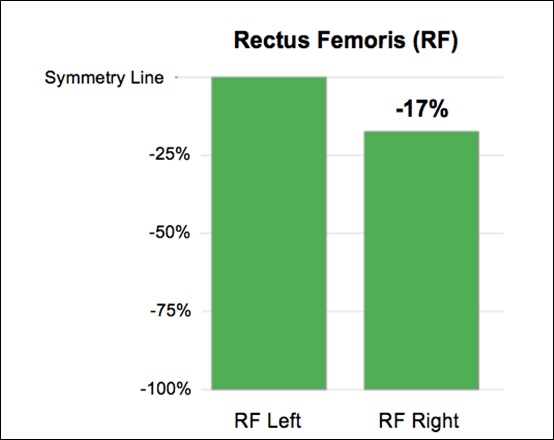Our new scoring system comes with a new set of terms: Muscle Fuel Symmetry (MFS) also makes a contribution to overall Muscle Health.
Overview
Differences in strength and power levels between corresponding left and right-sided limbs have been reported in athletes of all levels. These differences have been associated with increased injury risk and performance deficits. Both strength and power are linked to Muscle Fuel levels.
Definition
The symmetry (balance) of MuscleSound scores between corresponding right and left muscles of the upper or lower body.
Example
The illustration above displays the symmetry of MuscleSound scores for Right and Left Rectus Femoris (RF). The Right RF score is 17% lower than the Left RF score.
How do we obtain MFS scores?
- For each muscle pair scanned, differences are calculated between the individual values of MuscleSound scores
- From our database, the largest contralateral differences in MuscleSound scores are obtained between pairs of muscles, corresponding to those scanned during the session
- This score is represented as a 100% difference in symmetry
- Differences in the individual muscle pairs scanned are then compared to the maximum differences found in the database
- Symmetry is calculated for the lower scoring side as a percentage of the higher scoring side
- If no contralateral differences are found between muscle pairs, this would result in a maximum symmetry score (0% difference)
Why is MFS important?
- It can act as a surrogate for traditional methods of assessing contralateral differences in strength and power, since the fuel status of a muscle contributes significantly to the strength and force of its contraction
- Contralateral differences in strength and power have been reported in athletes of all skill and ability levels and are linked to increased injury risk and performance deficits.
- It can be used by coaches and/or nutritionists as an early warning of potential injury risk
- It can be applied to rehab situations: inadequate rehabilitation and premature return to play after injury have been identified as risk factors for injury recurrence
- It can be used to develop and monitor training routines designed to reduce any observed contralateral deficits
- In our MuscleSound report, the percentage score displayed on the graph is also expressed in terms of how it compares to the total MuscleSound database – i.e. ‘High’ – ‘Average’ – ‘Low’
Take Home Message: MFS is a non-invasive, easily acquired surrogate for traditional measures of contralateral injury risk. Potential strength/power deficits can be quickly screened for, and a much earlier determination made by the athlete/coach as to the need for further testing and evaluation.
In Practice
Read this great case story to understand how MFS looks and is used in practice.

